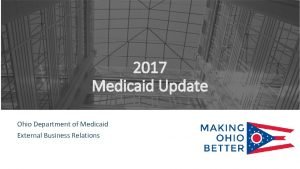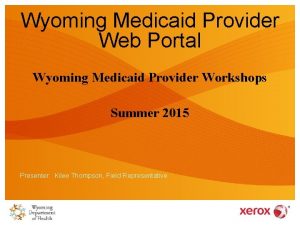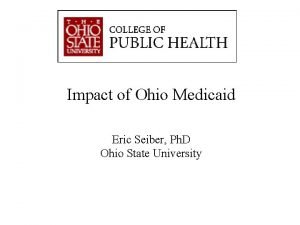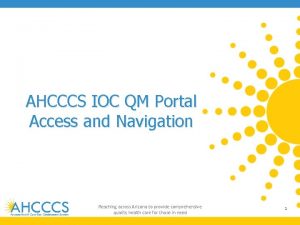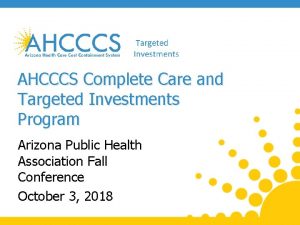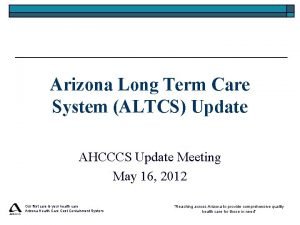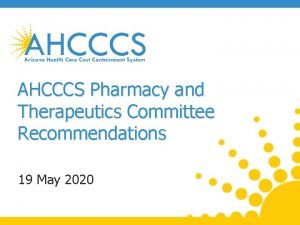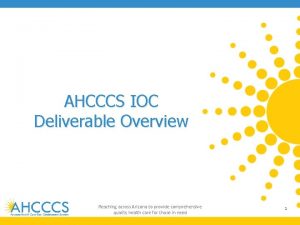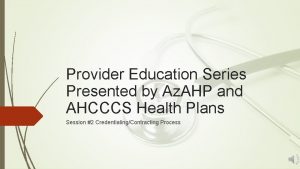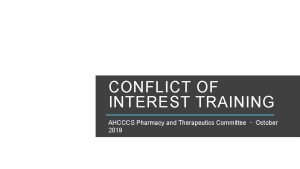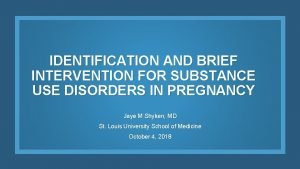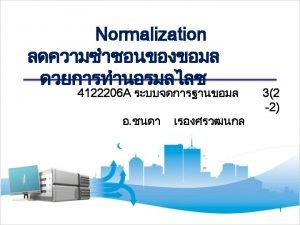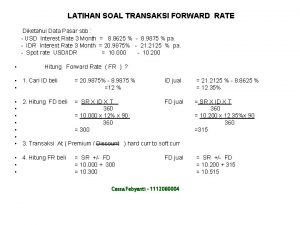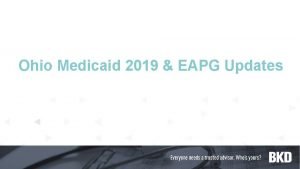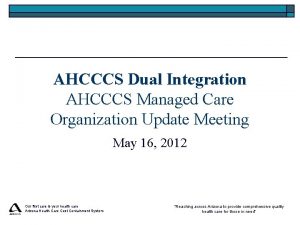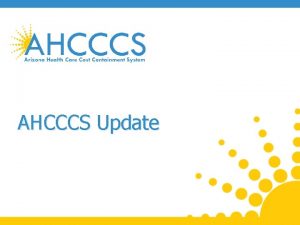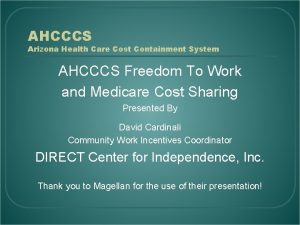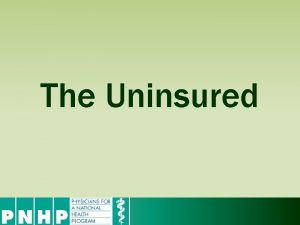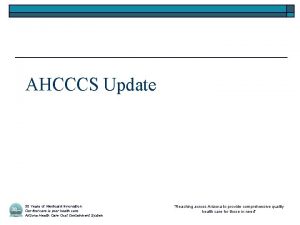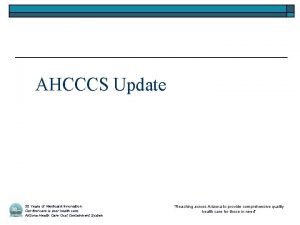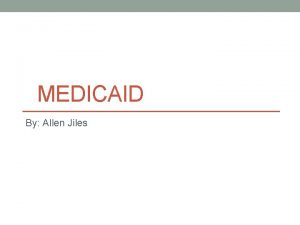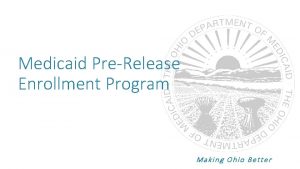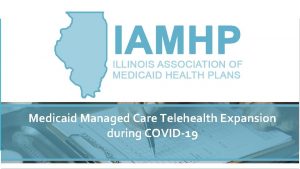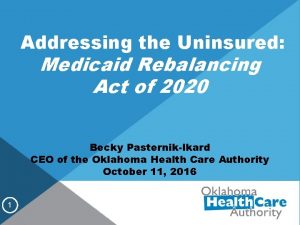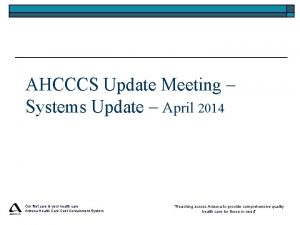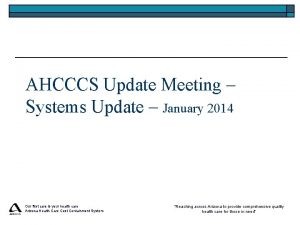AHCCCS Update Ohio Medicaid Expansion data Uninsured rate




















- Slides: 20

AHCCCS Update

Ohio Medicaid Expansion data • Uninsured rate for adults below 138% went from 32. 4% to 14% • 88% of 700, 000 were uninsured • 51% age 45 and older • 27% diagnosed with chronic condition after eligibility • 38. 8% had a chronic condition and 59. 1% reported easier to manage • 32% screened positive for depression or anxiety – 32. 3% had substance use disorder Reaching across Arizona to provide comprehensive quality health care for those in need 2

Ohio Summary • Reduced uninsured rate to lowest ever – • Improved access to care - innappropriate use shifted – new diagnosis of chronic issues • Nearly half reported improved health and only 3. 5% reported worsening • One third met screening criterial for depression or anxiety and they reported higher level of improvement • Coverage has allowed participants to better pay for other necessities • Supported employment and job seeking Reaching across Arizona to provide comprehensive quality health care for those in need 3

Speaker Ryan – A Better Way • Federal/State balance has shifted strongly to feds • Federal spending is unsustainable: o Growth from $350 billion in 2015 to an est. $624 billion in 2026 • Better Way: o Choice of per capita allotment or block grant § Phases down enhanced FMAP to regular FMAP – significant state fiscal impact CHIP back to original match o Limits CNOM authority to just Medicaid population o Grandfathers successful waivers o Does not cut DSH in 18 or 19 - Creates single uncomp care pool at fed level o Reaching across Arizona to provide comprehensive quality health care for those in need 4

A Better Way – Per Capita • Average expense for individual populations: Aged, Blind and Disabled o Children o Adults o • 2016 base trended to 2019 by inflation • DSH and GME separate • States would be given authority to better manage for non-disabled adults o o o Can require job search Enforceable reasonable premiums Can offer limited benefit package for optional population Can do premium assistance without wrap-around of other services States can use freezes and caps for non-mandatory populations; expansion states can reduce eligibility thresholds Reaching across Arizona to provide comprehensive quality health care for those in need 5

A Better Way – Block Grant More flexibility in state management of program • Required to serve elderly and disabled • Base assumes “expansion” population transitions to other sources of coverage (Prop 204 implications unclear) • States can keep savings • Still require stringent eligibility • Can require job search for “able bodied” • Can exclude undocumented individuals Reaching across Arizona to provide comprehensive quality health care for those in need 6

Risk Transfer Challenges • Transfer of risk to States is particularly challenging for Arizona o o o Previously expanded – loss of federal funds (See A Better Way) Voter-Protected coverage requirements (will not be able to avoid “available funding” in perpetuity) Overall lower per capita income to support programs and risk Large American Indian population – fed $ Particularly vulnerable in recessions (see Great Rec. ) Ongoing instability due to funding pressure will undermine managed care delivery system Reaching across Arizona to provide comprehensive quality health care for those in need 7

Risk Transfer Challenges (ctd. ) • Lower-cost more efficient state o o o o Fewer optional benefits (e. g. , no dental) High rates of HCBS Aligned Duals Low pharmacy spend Mature managed care – for almost all populations Delivery system performs well Few special payments funded with non-state $ Reaching across Arizona to provide comprehensive quality health care for those in need 8

How Will AZ Manage Risk? • Changes will be states’ responsibility and many will be very politically challenging: o o o Reducing Benefits Reducing Eligibility Reducing Payments Increasing Cost Sharing Program Administration • Will likely be annual discussion as part of state budget negotiations Reaching across Arizona to provide comprehensive quality health care for those in need 9

Examples of Flexibility – Mc. Carthy Letter 1. Freeze or cap certain eligibility group–ability to eliminate TMA 2. States should not have to cover all FDA approved drugs 3. Change FQHC reimbursements and statutes 4. Eliminate NEMT for certain populations 5. Increased cost sharing flexibility 6. Eliminate comparability and state-wideness 7. Eliminate Essential Health Benefits requirement 8. Allow more frequent eligibility redeterminations 9. Eliminate and reduce CMS regulatory burden 10. 1115 path to permanency Reaching across Arizona to provide comprehensive quality health care for those in need 10

Age Distribution of ACA members 140, 000 120, 000 100, 000 80, 000 100 -138% 0 -100% 60, 000 40, 000 20, 000 Under 20 20 -29 30 -39 40 -49 Reaching across Arizona to provide comprehensive quality health care for those in need 50+ 11

ACA-Related Member Services by Category Based on SFY 2015 Claims/Encounter Data 0. 2% 0. 9% 0. 7% 0. 4% 0. 6% 4. 9% Hospital Outpatient 5. 4% 22. 6% Hospital Inpatient Professional 5. 4% Pharmacy Medical Services Transportation Behavioral Health Institutional (NF) DME and Supplies 18. 3% HCBS Other Services 21. 7% Dental 19. 0% Reaching across Arizona to provide comprehensive quality health care for those in need 12

Annual Waiver Submittal • AHCCCS statutorily required to submit annual waiver requesting: Work requirement for all able-bodied adults o Establish one-year “ban” for knowingly failing to report change in income or making false statements re: work o Lifetime limit of 5 years for able-bodied adults o • Public Hearings in January/Submit in March Reaching across Arizona to provide comprehensive quality health care for those in need 13

Targeted Investment • • $300 million over 5 years 9 to 1 match Paid out through MCOs 3 Targeted Initiatives – Integration (Adult and Child) – Justice Transitions – • Need to re-scope proposal based on reduced funding – stay tuned Reaching across Arizona to provide comprehensive quality health care for those in need 14

Arizona Management System Governor’s Roadmap and Goal Council Employee Development & Engagement Visual Management Arizona Management System Business Reviews & Strategic Plan Leader Standard Work Reaching across Arizona to provide comprehensive quality health care for those in need

AMS Results • DBF project to increase providers paid electronically by 5%. Division hit 9% and increased target to 15%. • DFSM project to improve timeliness of authorizations for members needing level one facility admissions. The team reduced turnaround times by 75% • The DHCAA project to reduce the number of members that are awaiting advocacy support. August 2015 162 members on a waitlist (up to 24 months) today there are 37 members (longest wait time 2. 5 months). • DMS and OALS project improve the Trust Review process. Time needed decreased from 44 days in January of 2016 to average of 10 days. Trusts taking 15 days or more has gone from 45% to 14%. • OIG created a collections office project to collect 10% of the outstanding payments greater than 60 days. Today number is 18%. • HRD projects to reduce agency turnover. December 2015 turnover was 21%. In November 2016 15%. Reaching across Arizona to provide comprehensive quality health care for those in need 16

Other • IMD Waiver submittal – Indiana • FY 18 Budget o JLBC and OSPB relatively close o Assume 3% cap rate increase o Executive has funding for Emergency dental with $1, 000 cap o Includes recommendation expansion of newborn screening to include Severe Combined Immuno Deficiency (SCID) – rare genetic disorder that if not detected and treated early can be deadly Reaching across Arizona to provide comprehensive quality health care for those in need 17

Justice Involved and Recidivism Ind. /No recidivism Jul 1 2014 thru Dec 31 2014 240 Percent 6 -12 Mo 12 -18 Mo 16, 3, 6, 726 590 2, 317 41% Jan 1 2015 thru June 30 2015 661 Percent 8, 711 22% 20, 42% July 1 2015 thru Dec 31 2015 Percent 0 -6 mo 347 7, 953 872 19% 20, 541 14% 3, 1, 833 9% 2, 2 39% Reaching across Arizona to provide comprehensive quality health care for those in need 18

The Heroism of Incremental Care (Gawande) • Cites study that those who have primary care physician as their usual source of care had lower subsequent 5 -year mortality rate • In UK a 10% increase in primary care supply was shown to improve health so much that you could add 10 years to everyones life and still not match benefit • In California that provided all Medicaid recipients with primary care physician saw reduced hospital rates – Medicare plans that increased copays for primary care visits saw increased hospital • “Governments everywhere tend to drastically undervalue incrementalism and overvalue heroism” Reaching across Arizona to provide comprehensive quality health care for those in need 19

Incrementalism continued Ability to use and understand information is accelerating 1. Internal systems – imaging & labs 2. Living conditions – housing 3. State of care – what treatments and meds 4. Your behaviors – sleep – exercise Top Doc $ - Orthopedics – Cardiology – Dermatology – Bottom Doc $ – Pediatrics – Endroconology – Family Med 30% of Americans have high blood pressure – 50% get treatment 25% those who die before 75 do not need to with appropriate treatment 27% of adults are not insurable due to pre-existing conditions Resources made to surgeon and what’s available to pediatrician. . is immoral Reaching across Arizona to provide comprehensive quality health care for those in need 20
 Presumptive medicaid ohio
Presumptive medicaid ohio Wyoming medicaid provider
Wyoming medicaid provider Ohio medicaid eapg
Ohio medicaid eapg Is an alternative of log based recovery
Is an alternative of log based recovery Ahcccs qm portal
Ahcccs qm portal Mcos cover south gsa
Mcos cover south gsa Ahcccs altcs
Ahcccs altcs Ahcccs pharmacy
Ahcccs pharmacy Ahcccs qm portal
Ahcccs qm portal Ahcccs provider registration
Ahcccs provider registration Ahcccs pharmacy
Ahcccs pharmacy Madison county ohio sales tax rate
Madison county ohio sales tax rate Surp-p screening tool
Surp-p screening tool Update data sisdmk
Update data sisdmk Data redundancy and update anomalies
Data redundancy and update anomalies Oddex login
Oddex login Cap rate interest rate relationship
Cap rate interest rate relationship Real vs nominal interest rate
Real vs nominal interest rate Plant growth index
Plant growth index Contoh soal spot rate dan forward rate
Contoh soal spot rate dan forward rate Real exchange rate vs nominal exchange rate
Real exchange rate vs nominal exchange rate
